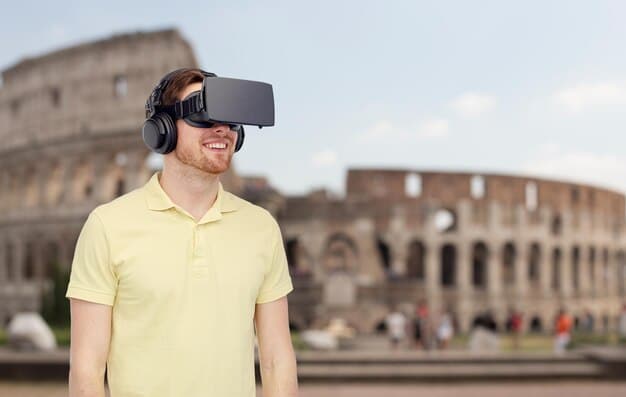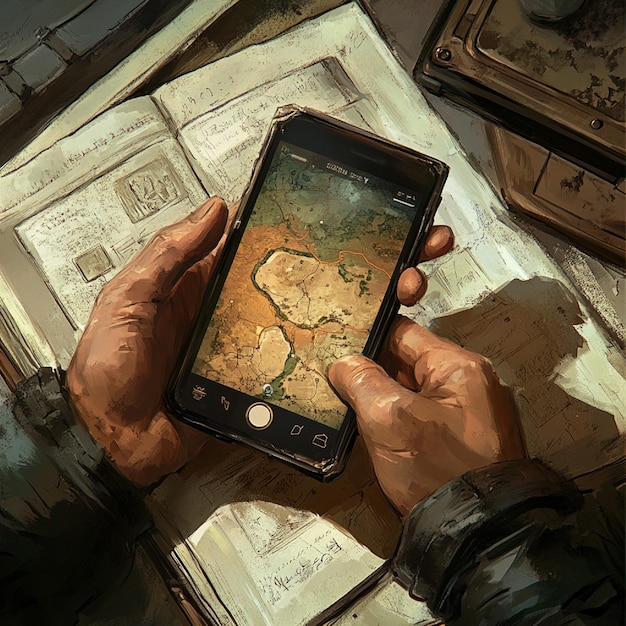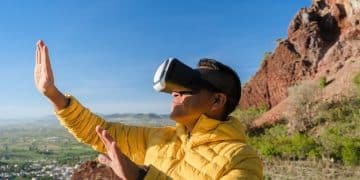The Future of Travel Writing: VR/AR Impact on Travel

The Future of Travel Writing: Will Virtual Reality and Augmented Reality Change the Game? is already being shaped by virtual reality (VR) and augmented reality (AR), offering immersive experiences that redefine how travelers explore destinations and how writers craft their stories.
The world of travel writing is on the cusp of a major transformation. The Future of Travel Writing: Will Virtual Reality and Augmented Reality Change the Game? The integration of virtual reality (VR) and augmented reality (AR) technologies promises to revolutionize how we experience and document travel.
The Rise of Immersive Travel Experiences
The integration of VR and AR into travel is no longer a futuristic concept; it’s a present-day reality. These technologies invite travelers to preview destinations, enhance their on-site experiences, and even revisit memories in profound new ways.
Virtual Reality: A Gateway to New Worlds
VR offers fully immersive environments that transport users to different locations without physical travel. This technology is becoming more sophisticated, providing lifelike visuals and interactive elements.
Augmented Reality: Enhancing the Real World
AR enriches the real-world environment by overlaying digital information onto the user’s view. This can include historical facts, interactive maps, and real-time translations.
- Pre-Travel Experiences: VR tours allow potential travelers to explore hotels, museums, and entire cities before booking a trip.
- On-Site Enhancements: AR apps offer interactive guides and historical context for landmarks, enriching the travel experience.
- Post-Travel Memories: VR and AR can be used to relive and share travel memories with friends and family.
The transformative potential of these technologies is clear. Travel writing must evolve to capture these new dimensions of exploration and engagement.

The Evolution of Travel Writing
Traditional travel writing, with its focus on descriptive prose and personal anecdotes, faces a challenge to adapt to a world where sensorial experiences can be digitally replicated and augmented. The question is not whether travel writing will change, but how.
From Description to Immersion
The role of the travel writer is shifting from a purely descriptive one to that of a curator of immersive experiences. The writer must guide the reader through the virtual or augmented landscape, highlighting key features and offering personal insights.
Blending Real and Virtual
Travel writing in the age of VR and AR requires a delicate balance between describing the real world and the digital enhancements that overlay it. Writers must engage with both the tangible and the intangible.
- Descriptive Storytelling: Travel writers must continue to hone their descriptive skills to create vivid and engaging narratives.
- Technological Integration: Writers need to understand and integrate VR and AR technologies into their storytelling.
- Ethical Considerations: The line between reality and simulation can be blurred by these technologies, raising ethical questions about authenticity and representation.
The evolution of travel writing hinges on the ability to seamlessly blend traditional storytelling with innovative technological integration.
The Impact on Storytelling Techniques
As VR and AR reshape travel, they also necessitate new approaches to storytelling. The immersive nature of these technologies demands a more interactive and personalized narrative style.
Interactive Narratives
VR and AR allow for branching narratives, where the user’s choices influence the story’s outcome. This requires travel writers to think more like game designers, creating multiple pathways and possibilities.
Sensory Storytelling
While VR and AR can stimulate sight and sound, they often fall short in replicating other senses like smell and touch. Travel writers must use language to fill these gaps, evoking the full sensory experience of a place.

- Personalization: VR and AR can tailor travel experiences to individual preferences, requiring writers to create content that appeals to a diverse audience.
- Emotional Connection: Despite the technological advancements, the human element remains crucial. Travel writers must connect with their audience on an emotional level, sharing their unique perspectives and insights.
- Authenticity: In a world of digital simulations, authenticity becomes even more valuable. Travel writers must strive to create genuine and trustworthy content.
By embracing interactive and sensory storytelling techniques, travel writers can create more immersive and engaging experiences for their readers.
The Challenges and Opportunities
Despite their potential, VR and AR present several challenges for travel writing. Issues of accessibility, cost, and authenticity must be addressed to fully realize the benefits of these technologies.
Accessibility and Cost
VR headsets and AR-enabled devices can be expensive, limiting access for many potential travelers. Travel writers must consider the accessibility of these technologies when creating content.
Authenticity and Representation
The line between reality and simulation can be blurred by VR and AR, raising concerns about authenticity and representation. Travel writers must be mindful of these ethical considerations.
Ethical Considerations:
The proliferation of VR and AR in travel raises ethical questions about cultural appropriation, environmental impact, and the potential for over-tourism. Writers must address these issues in their work.
Despite the challenges, VR and AR offer unprecedented opportunities for travel writers to create more immersive, engaging, and informative content.
Monetization and New Business Models
The integration of VR and AR opens new avenues for monetization and business models in the travel writing industry. From sponsored VR experiences to AR-enhanced guidebooks, the possibilities are vast.
Sponsored VR Experiences
Travel brands can partner with writers to create sponsored VR experiences that showcase their destinations or products.
AR-Enhanced Guidebooks
Traditional guidebooks can be enhanced with AR technology, offering interactive maps, historical information, and real-time translations.
Affiliate Marketing:
Travel writers can earn commissions by promoting VR headsets, AR apps, and other travel-related products.
By embracing these new monetization and business models, travel writers can thrive in the age of VR and AR.
Preparing for the Future
To prepare for the future of travel writing, writers must embrace new skills and technologies. This includes learning about VR and AR development, mastering interactive storytelling techniques, and staying abreast of industry trends.
Learning VR and AR Development
While not every travel writer needs to become a VR or AR developer, having a basic understanding of these technologies can be invaluable.
Mastering Interactive Storytelling
Travel writers must learn to create branching narratives and personalized experiences that cater to a diverse audience.
Staying Abreast of Industry Trends:
The world of VR and AR is constantly evolving, so travel writers must stay informed about the latest developments and trends.
By embracing these new skills and technologies, travel writers can position themselves for success in the future of travel writing.
| Key Aspect | Brief Description |
|---|---|
| 🥽 Immersive Experiences | VR and AR offer travelers fully immersive previews of destinations, enhancing pre-travel excitement. |
| ✍️ Storytelling Evolution | Travel writing is evolving from simple description to incorporating interactive and sensory elements. |
| 💰 Monetization | New models like sponsored VR experiences and AR guidebooks open revenue streams. |
| 🚀 Future Skills | Writers need to learn VR/AR development basics and interactive storytelling. |
Frequently Asked Questions
▼
VR provides immersive previews of destinations, allowing travelers to explore locations virtually before physically visiting. This enhances excitement and helps in planning by experiencing hotels and sights beforehand.
▼
AR enhances real-world travel by overlaying digital info on real-time views, offering instant access to historical data and interactive guides. This enriches the on-site experience with contextual layers.
▼
Travel writers need skills in VR/AR development basics and creating interactive narratives, allowing them to build engaging, immersive experiences. Staying updated with tech is also crucial.
▼
Monetization opportunities include sponsored experiences, where brands showcase destinations, and AR-enhanced guides that offer instant access to real-time info. Affiliate marketing of VR/AR tools is another.
▼
Ethics include cultural appropriation, environmental impact, and over-tourism. Writers must address these issues by promoting responsible travel and awareness of local cultures and environments.
Conclusion
The integration of VR and AR is poised to revolutionize the landscape of travel writing, offering unprecedented opportunities for immersive and interactive storytelling. By embracing these new technologies and developing the necessary skills, travel writers can continue to inspire and inform travelers in ever more engaging ways, ensuring that the future of travel writing is as exciting as the destinations it portrays.





